Four-box news story recipe

1. Lead: Anecdote, mini story that captures the essence of a person or an issue. It pulls the reader in while getting to the point FAST.
3. Meat in the Middle: Why should I believe you? Facts, quotes, statistics, background, context, documents, etc.
2. Nutgraph: “Uh, what’s the point?” Tell me why I should care. Presents the value of your content in a nutshell.
4. Kicker: Now, what? Leaves the reader with something to think about, circles back to a solution or drives home the point with a good quote.
How long does it take you to determine whether a news story is worth your time?
What are the story elements that keep you engaged?
Why do you think story construction matters more today than ever?
Let’s take a look at one AP story from 2021. Spend a few minutes reading this.
I doubt the reporter used a formula to craft that one; however, the reporter did apply a popular story-writing technique. You will learn that today.
The Four Box approach is a content strategy that will help you become a better news writer, researcher and reporter. Understanding and applying these four essential content areas for news/feature stories will help you brainstorm stories to help gauge value, find focus, interview sources and gather the best content to write and help you write a story that PEOPLE CAN’T WAIT TO READ.
- It’s a strategy to pull readers in – and keep them. It respects the readers’ time, while giving them a reason to keep reading. Give them stories, give them characters, give them emotion – essentially, give them reason to invest their time in your content.
- It will help you focus your interviews and writing: You will ask more focused questions to give you the details that you need to construct a narrative lead. It will help you think of the people affected by your topic. Think, “I need to show/tell why my audience should care.” What does this problem look like? Can you put a face to it? Can you give me an example?
- It will also remind you of the gaps you need to fill through authoritative sources, such as experts, facts, statistics and public documents. It will help you explain the “why” and the “how.”
- It will help you outline your story, so when you sit down to write, you will know the order in which it flows. You are not married to this structure, but as you’re gathering your content, it gives you a blueprint.
Time to open the boxes:
- Box #1: The Anecdotal Lead
- Box #2: The NUTGRAPH / Paragraph on why we should care
- Box #3: The Meat in the Middle – Statistics, Quotes, Anecdotes, Experts
- Box #4: The Kicker / Conclusion
When will I use it?
It can be applied to many multimedia media stories – news story, feature piece, personality profile, issue analysis, trend story, investigative piece, and many more. It answers the need for every piece of journalism to be timely, relevant, useful and interesting.

Box #1: The Anecdotal Lead
Professional journalists call this the “anecdotal lead,” and it is the most common way to begin a piece of journalism. It can be used with profiles, trend stories, feature stories, analytical pieces, news events, and many other types of stories. Generally it’s only a paragraph or two long.
An anecdote is only a small story, a small event that in some way illustrates the larger story that you are writing about. It could be one sentence or five.
Tip for creating this lead: Before you start your piece, ask yourself: “If I were at a dinner with friends and wanted to tell this story, instead of writing it, what’s the story I would start by telling?”
Example: Here is a story of a woman, crafted by a journalist who applied this strategy.
One morning, Maria Smith phoned home during her coffee break and learned that her 6-year-old son was running a fever of 103 degrees. She rushed to her boss for permission to drive her child to the hospital, but instead was coldly told: ‘Don’t bother coming back if you leave, because you won’t have a job waiting for you.’
That anecdote was a lead for an article about poor working conditions and lack of human rights for Mexican migrants working at the local vegetable canning plants.

Box #2: THE NUTGRAPH
This section is It where the journalist explains the wider significance of the small anecdote. It’s usually a paragraph long, or two at the most. In addition to showing the lead anecdote’s larger significance, the nut paragraph also often includes small news nuggets or highlighted facts that will be explored later in the story.
Example continued…
“Maria’s story is one of dozens of nearly identical tales told by seasonal workers at the Peppy Foods plant in Mapleville and at the company’s 16 other food-packing plants throughout the Midwest. In interviews with more than three dozen workers, a picture emerged of a company that routinely exposes its seasonal workers to hazardous working conditions even while it denies them access to medical care, affordable housing, and a minimum hourly wage.

Box #3: The Meat in the Middle:
Box #3 is the most free-form and varied part of journalistic articles. But it must explain or provide evidence for the claims you made in your nutgraph. Pull up top news sites online from a newspaper or news magazine and peruse a few pieces to see how many different ways writers develop their stories. Whatever their form, however, the middle section of stories always must support the statements and allegations made in the “lead” and “nutgraph” sections. Here, you can expand upon the major points you made in your nutgraph. This is where you have space to package the evidence and statements that support your main points.
In the most egregious case of abuse, one Mexican worker, according to county health records obtained yesterday, died after complaining of headaches but was forced to continue working until he collapsed. State legislators say this case and dozens of others documented by Migrant Rights International, a human rights group, are certain to influence a controversial “illegal immigration” bill that is supported by Governor Tim Plenty and scheduled for a vote this week.
You may introduce new voices and cite documents.
You can still weave storytelling and anecdotes into this section, sprinkling experiences with statistics and expert opinions.

Box #4: Kicker / Conclusion:
Think about what you want readers to think when they finish your story. Do you want them to think about a solution? Or leave with a feeling or hope or hopelessness or frustration….You could end with a quote. That’s common. You could circle back to the narrative lead and bring the reader back to the character. Allow them to close the story, with a “what’s next” from their perspective. Or you can allow experts to offer advice or an opinion on what will happen if something is not addressed. With a Kicker/closing, you are not slamming the door shut on a topic, never writing “in conclusion.” You leave the reader with something memorable, which is what all good stories do.
Taking something apart often helps us learn how to put it back together. Let’s deconstruct this story to explore its essential elements/ingredients.
Your turn: Now, let’s identify the four boxes through the lens of the Associated Press story.
COVID-19 spike worsens Africa’s severe poverty, hunger woes
By FARAI MUTSAKA / Associated Press
HARARE, Zimbabwe (AP) — Outside a foreign currency exchange in Zimbabwe’s capital, hordes of people desperate for U.S. dollars are pushed up against each other.
“That’s it, keep it tight,” some shout, trying to prevent others from jumping the line to buy the money that could get them a discount on goods pegged to a quickly devaluing local currency.
Nearly two years into a global pandemic, a new spike in coronavirus cases driven by the omicron variant is once again shuttering businesses, halting travel, reviving fears of overwhelmed hospitals and upending travel and holiday plans in countries around the world.
But in Zimbabwe and other African nations, the virus’s resurgence is threatening the very survival of millions of people who have already been driven to the edge by a pandemic that has devastated their economies. When putting food on the table is not a given, worries about whether to gather with family members for the holiday or heed public announcements urging COVID-19 precautions take a back seat.
“Yes, I have heard of the new variant, but it can never be worse than having nothing to eat at home right now,” says furniture store clerk Joshua Nyoni, one of the dozens waiting outside the exchange. Like many others in the chaotic crowd, Nyoni alternately wears his face mask below his chin or puts it in his pocket.
The United Nations Economic Commission on Africa, or ECA, noted in March that about 9 in 10 of the world’s extremely poor people live in Africa. The ECA now warns that the economic effects already felt since the pandemic began in 2020 “will push an additional 5 to 29 million below the extreme poverty line.”
“If the impact of the pandemic is not limited by 2021, an additional 59 million people could suffer the same fate, which would bring the total number of extremely poor Africans to 514 million people,” the agency says.
The World Bank estimates the economy went from 2.4% growth in 2019 to a 3.3% contraction in 2020, plunging Africa into its first recession in 25 years.
“The economic disruption wrought by COVID-19 has pushed hunger crises off a cliff,” Sean Granville-Ross, Africa regional director for the nonprofit charitable organization Mercy Corps, told The Associated Press.
Granville-Ross says his organization in 2021 saw “an alarming spike in need” in regions such as the Sahel, West Africa, East Africa and southern Africa where some countries were already experiencing humanitarian crises and conflict before COVID-19.
Worry is now intensifying amid a spike in COVID infections in Africa, which currently accounts for about 9 million of the world’s roughly 275 million cases.
The World Health Organization has for months described Africa as “one of the least affected regions in the world” in its weekly pandemic reports. But in mid-December it said the number of new cases was “currently doubling every five days, the fastest rate this year” as the delta and omicron variants push up infections. Both South Africa and Zimbabwe have been reporting reduced numbers over the past week, but authorities remain cautious.
Renewed travel restrictions and possible lockdowns “will only push millions more people to poverty and undermine the slight economic recovery we have started to see,” Granville-Ross says.
Compared to the continent as a whole, where just over 7% of the population has received two shots of the coronavirus vaccine, Zimbabwe is regarded as a success story — even though only about 20% of its 15 million people have been fully vaccinated.
Amid lingering hesitancy, the government has threatened to widen vaccine mandates. But for many people, virus infection fears have taken a back seat to the more urgent task of finding enough money to feed their families.
Dozens of residents desperate for access to money in an economy where cash, especially the U.S. dollar, is king, sleep outside both foreign currency exchanges and banks, huddled closely together for days. Elderly people, many without face masks or not properly wearing them, stand in tightly packed lines that snake for kilometers, waiting to withdraw their pensions.
“I would rather spend my time here than queue for the vaccine,” says Nyoni, outside the crowded foreign currency exchange.
“If I catch the virus, they may quarantine me, treat me or even feed me if I am hospitalized,” he says. “But hunger is different: You can’t be put in quarantine because the family has nothing to eat. People just watch you die.”
Let’s give this a try:
Apply the four-box template to one of the story ideas below, or come up with an idea of your own. Split into groups of two. You have 15 minutes.
- The price of gas is hurting college commuters, many of whom who say they are less likely to take part in clubs and campus activities.
- Therapy pets on campus help students cope with anxiety.
- The topic of your choice
Homework: Write a 550-word story
Writing #3: You will write a story, applying the four-box strategy, identifying a national story/issue that you can localize. One that affects students or community members close by. Think about what you need to fill those boxes. What sources will you seek? What questions will you ask them? What evidence will you need to prove that this is happening, that this is something that your audience should care about? It will be 500 words – no less. It must include:
- 2-3 sources, with quotes or dialogue from each at least two people.
- Evidence from a study or through a source to support your point.
- All ingredients of the four-box structure.
YOU HAVE TWO WEEKS
Next week, we’ll talk about the art of “chunking” content, again hitting upon these essential points and strategies in news stories.
- Driving the news
- Why it matters
- The big picture
- What we know
- What’s going on
- Between the lines
- By the numbers
- Close-up
- Why it’s important
- What they are saying
- What’s happening
- Flashback (for context)
- Details (using bullet points)
- Zoom in
- Zoom out
- What to watch
- Yes, but